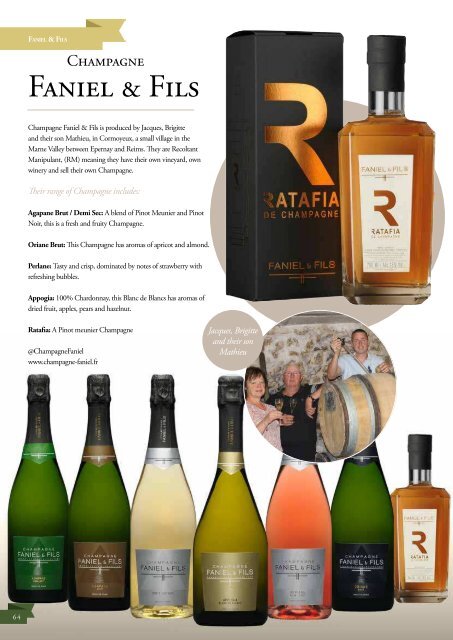You also want an ePaper? Increase the reach of your titles
YUMPU automatically turns print PDFs into web optimized ePapers that Google loves.
Faniel & Fils<br />
Champagne<br />
Faniel & Fils<br />
Nanotechnology<br />
Revolutionises Riddling<br />
Deborah Parker Wong<br />
Champagne Faniel & Fils is produced by Jacques, Brigitte<br />
and their son Mathieu, in Cormoyeux, a small village in the<br />
Marne Valley between Epernay and Reims. They are Recoltant<br />
Manipulant, (RM) meaning they have their own vineyard, own<br />
winery and sell their own Champagne.<br />
Darko Makovec<br />
There’s no mistaking a gyropalette at<br />
work but you’ll need a scanning electron<br />
microscope to see the iron nanoparticles that<br />
have the potential to make it obsolete.<br />
By Deborah Parker Wong, AIWS<br />
Arthur O’Connor<br />
Their range of Champagne includes:<br />
Agapane Brut / Demi Sec: A blend of Pinot Meunier and Pinot<br />
Noir, this is a fresh and fruity Champagne.<br />
Oriane Brut: This Champagne has aromas of apricot and almond.<br />
Perlane: Tasty and crisp, dominated by notes of strawberry with<br />
refreshing bubbles.<br />
Appogia: 100% Chardonnay, this Blanc de Blancs has aromas of<br />
dried fruit, apples, pears and hazelnut.<br />
Ratafia: A Pinot meunier Champagne<br />
@ChampagneFaniel<br />
www.champagne-faniel.fr<br />
Jacques, Brigitte<br />
and their son<br />
Mathieu<br />
A team of biochemists working in conjunction with a<br />
nanotechnology researcher have introduced a riddling<br />
technique that uses nanoparticles and a magnet to riddle a<br />
bottle of sparkling wine in approximately fifteen minutes.<br />
Biochemical engineer and Professor Dr. Marin Berovic and his<br />
team at the University of Ljubljana, Slovenia and nanotechnology<br />
researcher Professor Dr. Darko Makovec, who heads the Jozef<br />
Stefan Institute’s Department for Materials Synthesis, developed<br />
an elegant and inexpensive method of bonding silica-coated<br />
nanoparticles of iron oxide to yeast cells (a mass ratio of 1:10)<br />
and then using a strong permanent magnet to sediment the spent<br />
magnetized yeast cells.<br />
“The method itself is 4,000 times faster than classical hand<br />
remuage,” said Berovic who is currently a visiting professor<br />
at the University Catolica de Santiago, Chile. The speed and<br />
efficiency of the process which has already been widely studied<br />
and applied in biotechnology and water purification relies on the<br />
absorption of super paramagnetic amino-functionalized iron oxide<br />
maghemite nanoparticles onto both Saccaromyces cerevisiase and<br />
Saccharamyces bayanus yeast cells.<br />
In a three-part process, iron oxide nanoparticles are coated with<br />
silica which is grown around them in<br />
a thin, protective layer. Molecules<br />
providing surface amino groups are<br />
grafted onto the positively-charged<br />
nanoparticles which are then<br />
introduced to the yeast cell culture. The<br />
nanoparticles bond to the negativelycharged<br />
yeast cell membranes and<br />
are dispersed as the yeast cells divide<br />
and then cluster together after<br />
fermentation. Once spent, the yeast<br />
cells are separated from the wine using<br />
a strong magnet at the neck of the<br />
bottle (see Fig.1).<br />
The study points out that the level of iron present in the finished<br />
wine fell below the 10.00 mg/L range allowed by the European<br />
Union in white wine at 8.30 +/-1.6 mg/L Fe3+. Although iron<br />
oxide nanoparticles are considered non-toxic and they have<br />
been approved for use in living medical applications, standard<br />
winemaking chemistry identifies unstable levels of iron at above<br />
6 mg/L in white wine which can result in white iron phosphate<br />
deposits or iron casse. Researchers have yet to determine if the iron<br />
ions in the finished wine are the result of nanoparticles that remain<br />
after separation or were partially dissolved during the process.<br />
Arthur O’Connor who directs winemaking for the<br />
CordoniuRaventos Group, the parent company of Cava category<br />
leader Cordoniu, and is president of Artesa Winery in Sonoma,<br />
Calif., said, “We’ve spent years and years figuring out which yeasts<br />
give us the best results.” O’Connor is currently using a proprietary<br />
form of agglomerated yeast in conjunction with a special<br />
gyropalette that has reduced riddling time to about one hour.<br />
While yeast trials have been costly and time consuming for<br />
CordoniuRaventos, the company continues to be an early adopter,<br />
“We follow current research and treat new ideas very seriously,” he<br />
said. “In addition to riddling, there also seems to be considerable<br />
potential for using magnetized metal and electromagnetic fields in<br />
developing new methods for sterile filtration and color extraction in<br />
still wines.”<br />
The sensory evaluation of magnetic-yeast fermented wines could<br />
well be an arbiter of success. Sensory evaluation revealed that<br />
magnetized-yeast fermentation slightly increased the intensity of<br />
aromatic compounds and mouth feel in finished wines with apple,<br />
citrus fruits, pear and honey-melon flavors being more apparent to<br />
tasters. Color intensity, body structure and CO2 bubble texture<br />
were deemed identical to the high quality sparkling control wines.<br />
The technology which has been published in its entirety in the<br />
March 2014 edition of the Biochemical Engineering Journal is<br />
patented in Slovenia and is now making its way through the EU<br />
patent process. Adoption by the sparkling wine industry would<br />
enable many producers to leapfrog several generations of yeast<br />
technology and forgo use of the gyropalette forever.<br />
64 65


